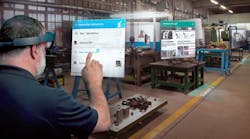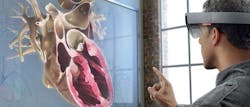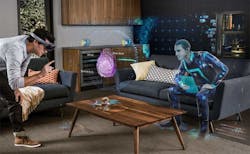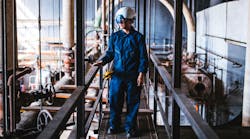When Microsoft released the Developer's Edition of the HoloLens in 2016, enterprise software maker Upskill was one of the first to receive the head-mounted computer. At the time, the $3,000 device was promised as a wearable doorway to an amazing new place to work and play, able to transport video game players and design engineers to mixed reality.
A variation on augmented reality, this immersive technology allows the holograms displayed on your visor to appear in the physical world. Simple finger movements then allow these digital enhancements to be enlarged, shrunk or moved just as easily as any window or icon on a smartphone screen.
Microsoft offers 446 various apps, ranging from educational to sports performance trackers. One game turns your finger into a laser blaster to quell an alien invasion in your living room, while a medical app created at Case Western Reserve University allows researchers to examine massive digital simulations of the brain and circulatory system, a la Fantastic Voyage or Innerspace.
"I’ve looked at data sets like this for 10 years, and I never fully understood their 3D structure until I saw them in HoloLens," recalled Mark Griswold, a radiology professor at CWRU.
Upskill went a less fantastical route, focusing on how it can leverage the HoloLens to provide real efficiency gains for its Skylight platform users in the manufacturing space, like it previously proved with smartglasses. These assisted-reality applications included virtually pulling in remote experts to troubleshoot broken equipment or providing hands-free work instructions for complex assembly.
This October, the Washington D.C.-based company announced Skylight for Microsoft HoloLens, available for free to all current Skylight enterprise licensees.
Features include:
● Spatial content placement to drop and move PDFs and other digital content (including videos) anywhere in a worker's field of vision, making the world around them a 360-deg giant computer desktop.
● Multi-window viewing to look at and organize several pieces of content content in one, as if they were arranging multiple screens.
● Native content integration to access and display work instructions and engineering drawings in PDF format in real-time and without needing to transcode or reauthor content
● Natural user interaction, which allows users to directly navigate applications, interact with content and reposition information within a workspace through simple hand or head gestures.
"This is the continued evolution of the right tool for the right job-value proposition," says Jay Kim, Upskill's Chief Strategy Officer.
With the software update so new, Upskill has not released exactly how much time can be saved and downtime spared with HoloLens, but previous uses of the AR platform have cut production time by 25% (Boeing using Google Glass Enterprise Edition).
"We expect similar performance metrics on this solution," Kim attests.
If that hold true, it's safe to say the HoloLens will be an instant hit on the factory floor.
It could also radically alter operation's expectations. The questions of how long it should take to install or fix machinery, perform routine maintenance, or even train new employees at a workstation could possibly be measured in minutes instead of hours.
That's because, from a technology standpoint, using smartglasses equipped with a monocular display is not all that different than clipping a smartphone to the brim of a ballcap. Putting on a HoloLens gives you the same powers of Harry Potter in the Matrix. You can manifest anything you want to tackle any task. And all those features mentioned above are working all the time, amplifying each other. Even if you work with extended displays, you know those screens fill up in a hurry for complex jobs.
For a maintenance job on a robot, you can lock several pages of work instructions to your left, and have a video demo left by your integrator to the right of the machine you’re working on. Need a close up of the circuit path? Turn your head to the left, look directly at the page and extend your index finger from your thumb to magnify the schematics.
All these micro gestures (as opposed to flipping through paper instructions or even searching through a tablet) helps the job get done faster with the minimum amount of effort. That's good for the company, but even better for the tech or engineer performing it.
"The problem we are trying to solve for now is reducing the amount of steps a hands-on worker needs to take," Kim says. "When they walk to the workstation to input or look up information, it all comes down to ergonomics. If they take 30% fewer steps, that person is likely to sleep a little better at night and ache a little less."
While it's exciting to imagine how HoloLens, and other mixed reality devices, can drive key performance indicators on the factory floor, Kim says Skylight for HoloLens is optimized for specific tasks, not for an entire 8-hour shift.
"It's fair game to think the tech will evolve, and we can see it in an all-day everyday scenario," Kim says, "but to drive value now, we've put guardrails into the user experience, to make sure it's intuitive and comfortable."
And that may be the biggest selling point for the device that looks more appropriate for RoboCop cosplay than a factory. You don’t need to be an experienced gamer or tech savvy tween to instantly get a hang of things.
"Whenever I show to this to a potential customer or partner, the best part is seeing that smile on their face when they put on the HoloLens and realize they already know how to use it, especially for something like moving a window," says Andrew Sugaya, director of product strategy. "You tap and drag it like any other object on a smart device."














